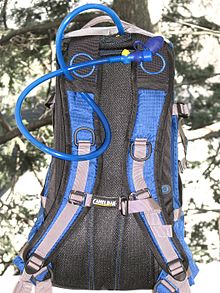
In physiology, dehydration is a lack of total body water, with an accompanying disruption of metabolic processes. It occurs when free water loss exceeds free water intake, usually due to exercise, disease, or high environmental temperature. Mild dehydration can also be caused by immersion diuresis, which may increase risk of decompression sickness in divers.
Survivalism is a social movement of individuals or groups who proactively prepare for emergencies, such as natural disasters, and other disasters causing disruption to social order caused by political or economic crises. Preparations may anticipate short-term scenarios or long-term, on scales ranging from personal adversity, to local disruption of services, to international or global catastrophe. There is no bright line dividing general emergency preparedness from prepping in the form of survivalism, but a qualitative distinction is often recognized whereby preppers/survivalists prepare especially extensively because they have higher estimations of the risk of catastrophes happening. Nonetheless, prepping can be as limited as preparing for a personal emergency, or it can be as extensive as a personal identity or collective identity with a devoted lifestyle.

Camping is a form of outdoor recreation or outdoor education involving overnight stays with a basic temporary shelter such as a tent. Camping can also include a recreational vehicle, sheltered cabins, a permanent tent, a shelter such as a bivy or tarp, or no shelter at all. Typically, participants leave developed areas to spend time outdoors, in pursuit of activities providing them enjoyment or in a form of educational experience. Spending the night away from home distinguishes camping from day-tripping, picnicking, and other outdoor activities.

Backpacking is the outdoor recreation of carrying gear on one's back while hiking for more than a day. It is often an extended journey and may involve camping outdoors. In North America, tenting is common, where simple shelters and mountain huts, widely found in Europe, are rare. In New Zealand, hiking is called tramping, and tents are used alongside a nationwide network of huts. Hill walking is equivalent in Britain, though backpackers make use of a variety of accommodation, in addition to camping. Backpackers use simple huts in South Africa. Trekking and bushwalking are other words used to describe such multi-day trips.
Urophagia is the consumption of urine. Urine was used in several ancient cultures for various health, healing, and cosmetic purposes; urine drinking is still practiced today. In extreme cases, people may drink urine if no other fluids are available, although numerous credible sources advise against using it. Urine may also be consumed as a sexual activity.

A survival kit is a package of basic tools and supplies prepared as an aid to survival in an emergency. Civil and military aircraft, lifeboats, and spacecraft are equipped with survival kits.

Survivorman is a Canadian-produced television program, broadcast in Canada on the Outdoor Life Network (OLN), and internationally on Discovery Channel and Science Channel. The title refers to the host of the show, Canadian filmmaker and survival expert Les Stroud, who uses survival skills and knowledge to survive alone for up to ten days, in remote locales where he brings with him little or no food, water, or equipment. Each location was scouted and planned extensively by Stroud and his team who consulted with survival specialists and natives of each area. The fact that Stroud films the episodes himself and endures the challenges of the wilderness, while dealing with the concomitant mental, emotional and physical stresses, is a major focus of the show.

Bushcraft is the use and practice of skills, thereby acquiring and developing knowledge and understanding, in order to survive and thrive in a natural environment.
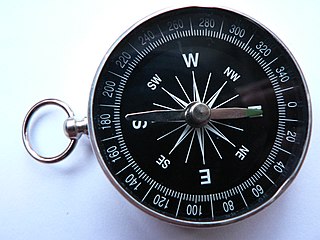
The Ten Essentials are survival items that hiking and Scouting organizations recommend for safe travel in the backcountry.
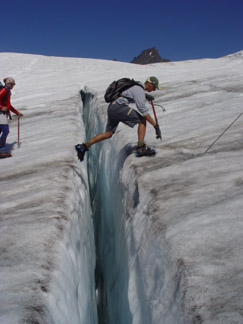
Outdoor recreation, such as hiking, camping, canoeing, cycling, or skiing, entails risks, even if participants do not recklessly place themselves in harm's way. In some circumstances, such as being in remote locations or in extreme weather conditions, even a minor accident may create a dangerous situation that requires survival skills. However, with correct precautions, even fairly adventurous outdoor recreation can be enjoyable and safe.
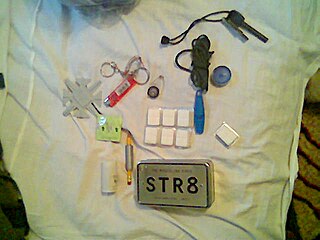
A mini survival kit contains essential outdoor survival tools and supplies. It is intended to be carried on one's person at all times, be appropriate to all environments, and be a comprehensive kit without being too large. Mini survival kits are intended to provide the basic needs of a survival situation, self-rescue, assistance or a return to normalcy in optimum situations.
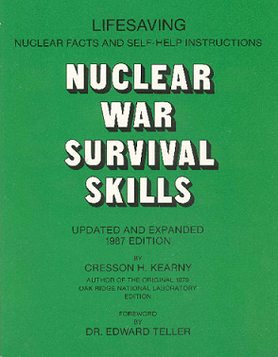
Nuclear War Survival Skills or NWSS, by Cresson Kearny, is a civil defense manual. It contains information gleaned from research performed at Oak Ridge National Laboratory during the Cold War, as well as from Kearny's extensive jungle living and international travels.

Ultralight backpacking is a style of lightweight backpacking that emphasizes carrying the lightest and least amount of gear. While no technical standards exist, some hikers consider "ultralight" to mean an initial base weight of less than 4.5 kg (9.9 lb). Base weight is the weight of a fully loaded backpack at the start of a trip, excluding worn weight and consumables such as food, water, and fuel. Base weight can be lowered by reducing the weight of individual items of gear, or by choosing not to carry that gear. Ultralight backpacking is most popular among thru-hikers.
Hiking equipment is the equipment taken on outdoor walking trips. The duration, distance, planned activities, and environment impacts equipment selection. For example, a short day hike across flat farmland versus trekking in the Himalayas would call for different types of equipment.

In the survivalist subculture or movement, a retreat is a place of refuge. Sometimes their retreats are called a bug-out location (BOL), a bunker, a bolt hole or a hidesite. Survivalist retreats are intended to be self-sufficient and easily defended. Generally, they are located in sparsely populated outback rural areas.
Bradford Angier was an American wilderness survivalist and proponent of back-to-earth living. He authored more than 35 books on how to survive in the wild and how to live minimalisticly off the land.
Portrayals of survivalism, and survivalist themes and elements such as survival retreats have been fictionalised in print, film, and electronic media. This genre was especially influenced by the advent of nuclear weapons, and the potential for societal collapse in light of a Cold War nuclear conflagration.

Camping food is food brought on or designed for camping, hiking, and backpacking trips. The term also encompasses ingredients that can be used to make said foods. The primary differences relate to campers' and backpackers' special needs for foods that have appropriate cooking time, perishability, weight, and nutritional content. To address these needs, camping food is often made up of freeze-dried, dehydrated, pre-cooked, pre-prepared, or otherwise preserved foods that can last extended periods.

Survive This is a Canadian reality television show in which eight teenagers with limited survival skills training are taken into a forest and confronted with a number of survival challenges to test their skills and perseverance. The series aired on YTV in Canada and Cartoon Network in the United States. The show is hosted by Les Stroud, who narrates each episode, provides the teens with survival challenges, and assesses their performance. The show premiered on April 7, 2009, in Canada and on June 17, 2009, in the United States. Cartoon Network ceased to air Survive This after August 19, 2009, and screened the final three episodes only on the network's website.

The SAS Survival Handbook is a survival guide by British author and soldier, John Wiseman, first published by Williams Collins in 1986. Second, revised edition came out in 2009. A digital app for smartphones based on the book is also available. The book spans over 11 sections, and an introduction and postscript, detailing how to survive in dangerous surroundings.



